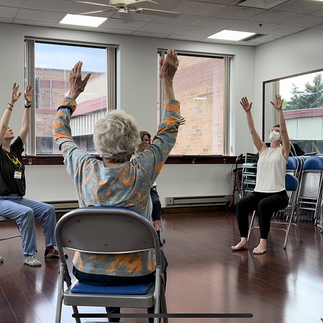
By Steve Sucato
Continuing the fruitful relationship GroundWorks DanceTheater has had with Judson Senior Living over the years, the company, this past spring, presented its final Education and Outreach residency program, Spring Into Motion.
Facilitated by company Director of Education & Community Engagement Joan Meggitt and Lead Teaching Artist Morgan Ashley, Spring Into Motion engaged residents at Judson Manor, Judson Park, and South Franklin Circle in various social, wellness, and arts programs. The hour-long sessions, one day a week for eight weeks, focused on the expressive potential in everyone through dance/movement exploration. The sessions were adapted to each Judson Senior Living site and ranged from activities that told peoples' stories, explored different movement aesthetics and celebrated individual and cooperative creativity and achievement.
Acknowledging the health and mobility needs of the sessions’ participants, Meggitt says each began with the participants seated for warm-up exercises. Depending on their mobility, participants then did standing exercises such as stretching using their chairs for support, waking up their sensations and movement across the floor.
Other exercises included “passing movement around,” which Meggitt describes as the participants handing one another an imaginary ball of light or giving a gift, and inscription, in which the participants moved their bodies to draw their names in the air.
“The exercises were ways to shift from focusing on the self getting ready and opening up to focus on the other people in the room and entering into relationship with them,” says Meggitt.
The main body of the residency program focused on different dance techniques each week so that the participants learned a little about the movement techniques GroundWorks’ company dancers might use.
“Session one was an introduction, and session eight was our wrap-up,” says Meggitt. The six sessions in the middle covered folk and social dance, ballet, modern, jazz, tap and musical theater, and contemporary dance.
“During those sessions, we would do two exercises specific to those dance forms,” says Meggitt. For instance, for ballet, we did basic pliés and port de bras, showing the gracefulness and regality of the dance form and how those could be expanded improvisationally. ”
In addition to teaching the technical qualities of each dance form, Meggitt and Ashley briefly imparted some dance history on each form, sometimes demonstrating movement for the participants. They also introduced a creative component to the sessions, having the participants think about how they would create a dance in a particular style.
Meggitt says she would prompt the participants with questions such as, “If you were to make a folk dance and the first thing you had to do was greet someone, how would you do it? Would you bow or wave?”
For other dance styles, such as musical theater, Meggitt used a theme based on West Side Story. In this theme, the participants created characters, formed gangs, and created dance movements in which they battled one another.

Meggitt says the participants at each Judson location were very engaged and curious. “They asked many questions about the dance forms and brought their thoughts and opinions to the sessions.”
For the final session in week eight, the session participants requested revisiting folk dancing and also having Meggitt and Ashley perform for them. “Morgan and I created a short dance that incorporated each of the dance styles we taught them,” says Meggitt. “It was a lot of fun, which has been an underlying goal with our education and outreach efforts over the years.”






